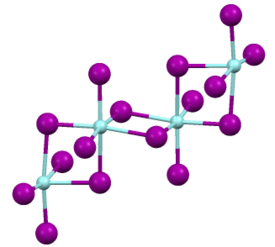
| |
| Names | |
|---|---|
| Other names
zirconium tetraiodide
| |
| Identifiers | |
3D model (JSmol)
|
|
| ChemSpider | |
| ECHA InfoCard | 100.034.332 |
| EC Number |
|
PubChem CID
|
|
| UNII | |
CompTox Dashboard (EPA)
|
|
| |
| |
| Properties | |
| ZrI4 | |
| Molar mass | 598.842 g/mol |
| Appearance | orange-yellow crystalline hygroscopic |
| Density | 4.914 g/cm3 |
| Melting point | 499[1] °C (930 °F; 772 K) (triple point) |
| Boiling point | 431 °C (808 °F; 704 K) (sublimes) |
| Structure | |
| Monoclinic, mP30 | |
| P2/c, No. 13 | |
| Hazards | |
| GHS labelling: | |

| |
| Danger | |
| H314 | |
| P260, P264, P280, P301+P330+P331, P303+P361+P353, P304+P340, P305+P351+P338, P310, P321, P363, P405, P501 | |
| NFPA 704 (fire diamond) | |
| Related compounds | |
Other anions
|
Zirconium(IV) fluoride Zirconium(IV) chloride Zirconium(IV) bromide |
Other cations
|
Titanium tetraiodide Hafnium tetraiodide |
Except where otherwise noted, data are given for materials in their standard state (at 25 °C [77 °F], 100 kPa).
| |
Zirconium(IV) iodide is the chemical compound with the formula ZrI4. It is the most readily available iodide of zirconium. It is an orange-coloured solid that degrades in the presence of water. The compound was once prominent as an intermediate in the purification of zirconium metal.
